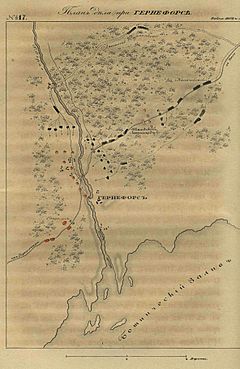Battle of Hörnefors facts for kids
Quick facts for kids Battle of Hörnefors |
|||||||
|---|---|---|---|---|---|---|---|
| Part of the Finnish War (Napoleonic Wars) | |||||||
 Duncker såras i striden vid Hörnefors, by Johan Tirén |
|||||||
|
|||||||
| Belligerents | |||||||
| Commanders and leaders | |||||||
| Strength | |||||||
| 2,400 8 guns |
3,350 4 guns |
||||||
| Casualties and losses | |||||||
| 167 | 188 | ||||||
The Battle of Hörnefors was a fight that happened on July 5, 1809, during the Finnish War. This war was part of the bigger Napoleonic Wars in Europe. In this battle, about 2,400 Swedish soldiers, led by Johan August Sandels, fought against roughly 3,350 Russian soldiers. The Russian forces were commanded by Ilya Alekseyev and Pavel Andreyevich Shuvalov. The battle took place in Hörnefors, Sweden. After more than two hours of intense fighting near the Hörnån river, the Swedish commander, Sandels, ordered his troops to retreat. He had received incorrect information about a large Russian attack trying to surround his army.
Contents
What Led to the Battle
After a previous battle in Skellefteå, Russian forces captured Umeå on June 1. Johan August Sandels then took charge of the Swedish troops near Umeå. His army had about 1,450 men at first, and their situation was tricky. They worried about Russian troops trying to go around them or cutting off their escape if they moved south.
However, the Swedish navy arrived in the Gulf of Bothnia. This helped protect the coast and made it harder for the Russians to get supplies by sea. Sandels also learned that the Russian defense line near the Ume River might be weaker than thought. He believed the Russians had only 1,200 men and 8 cannons. Meanwhile, his own army grew to 2,400 men.
Because of this, Sandels decided to attack. His plan was to advance through Hörnefors. But their march was slower than expected. This meant the Swedes lost the element of surprise, and the Russians had time to gather more soldiers.
The Battle Begins
The Russian forces pushed the Swedish advance guard (the first part of the army) back to Hörnefors. The main Swedish army gathered there on July 4. The Russian commander, Pavel Andreyevich Shuvalov, was replaced by Ilya Alekseyev due to illness. The Russian army now had 3,350 men and 4 cannons. Alekseyev first thought about retreating, but Shuvalov, who stayed with the army, told him to counterattack.
The Russian attack began from Sörmjöle on July 5. At nine in the evening, most of the Russian army started a direct attack. They pushed back the Swedish patrols. At the same time, two groups of Russian soldiers tried to go around the sides of the Swedish army. Sandels was surprised by this attack, as he expected it the next day.
The Russian group trying to go around the northern side was stopped by the Österbotten battalion. The southern group also faced resistance from two battalions from the Hälsinge and Jämtland regiments.
The rest of the Swedish soldiers held the middle ground along the Hörnån river. They defended the two bridges crossing the river. One battalion was positioned furthest to the right, near the river mouth, but it wasn't involved in the fighting. Half of another battalion was kept in reserve.
At half past ten, after more than two hours of intense fighting, Sandels ordered a retreat. He had received a false report that the Russians had surrounded his left side. The Savolax 2nd Battalion, led by Joachim Zachris Duncker, acted as the rearguard (the group that protects the main army during a retreat). They covered the Swedish withdrawal under heavy Russian pressure. Duncker was badly wounded and died later. His battalion suffered significant losses.
Swedish Army Groups
Here are some of the main Swedish groups that fought in the battle:
- Hälsinge Infantry Regiment: 1 battalion
- Jämtland Infantry Regiment: 2 battalions
- Swedish Infantry Battalion (made of soldiers who had recovered from injuries or sickness): 1 battalion
- Österbotten Field-Battalion: 1 battalion
- Savolax 1st Field-Battalion: 1 battalion
- Savolax 2nd Field-Battalion (from Savolax and Karelian jägers): 1 battalion
- Nyland and Karelian Dragoons: 10–20 horsemen
- Artillery: 8 cannons and 62 men
In total, the Swedish forces had about 2,400 men and 8 cannons.
What Happened Next
Fewer than 2,000 Swedish soldiers and about 2,700–3,000 Russian soldiers were actually involved in the fighting. The Swedes lost 10 officers and 157 regular soldiers who were killed, wounded, or captured. The Russians had 8 officers and 180 regular soldiers killed or wounded.
On the morning of July 6, the Swedish army crossed the Öre River. They set up new defenses close to where they had been before. After this battle, fighting in northern Sweden stopped. This was because peace talks were happening. This was also the last battle of the war where troops from what is now Finland fought.
Sweden had been ready to give Finland to Russia for some time. However, Russia's emperor, Alexander I, wanted even more land, up to the Kalix River. On August 16, the Swedes landed a large force at Ratan. Their goal was to free Västerbotten from Russian control. This would help them get better terms in the peace treaty. The two sides soon fought the final battles of Sävar and Ratan. After these battles, a peace treaty was signed in Fredrikshamn.
Images for kids



